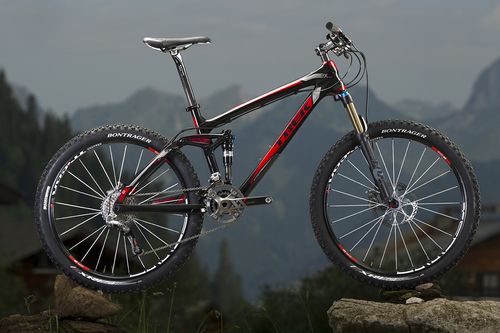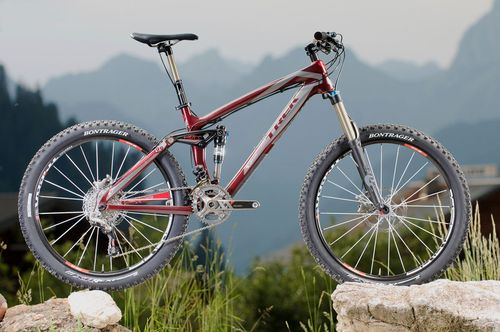For 2011, Trek has gone back over virtually its entire mountain-bike line and, rather than introduce new models, has refined existing platforms. Weights are lighter, handling is stiffer, and suspension is more precisely tuned. In July, the company offered a peak of its 2011 offerings in the ski-resort town of Chatel, along the French-Swiss border.
Trek has several new technologies showing up throughout its line. A new carbon process called OCLV Mountain, which the company claims is 25 percent stronger than standard carbon and, thus, better able to handle off-road riding, shows up in its trail, all-mountain, and freeride bikes. This durability is further bolstered by Trek’s Carbon Armor, a rubberized pad on the downtubes of the carbon bikes to protect against blows from rocks. (Trek says downtube damage from trail debris accounts for 80 percent of the warranty claims it receives for carbon mountain bikes.)
Trek’s ABP design, which places a suspension pivot on the rear axle dropout to deliver better suspension performance under braking, gets refined, as well. Trek claims the existing ABP was already 30 percent stiffer than standard dropouts (meaning better handling precision). The new design, an option called ABP Convert, enables customers to switch from a standard quick-release dropout in the rear to a 12mm thru-axle setup, which Trek claims is 40 percent stiffer than standard systems.
Trek plans an early fall rollout for its pure cross-country race bikes, the Top Fuel and 9.9 hardtail. So more on those later. But here’s how the refinements are playing out in the rest of the line, along with first impressions from test rides around Chatel.
Fuel EX
Trek’s popular Fuel EX five-inch trail bike is now, in the top-end 9.9 model, a full-carbon frame. The aluminum chainstays of the 2010 model have been replaced with carbon ones, which brought frame weight down a full 100 grams (3.5 ounces). Trek claims a complete Fuel EX 9.9 weighs in the 22-pound range, even with the inclusion of OCLV Mountain carbon, Carbon Armor, and the ABP Convert dropouts.

I spent six hours on the new EX in Chatel, pushing it on long climbs and rocky, technical descents. I’ve always been a fan of the Fuel EX. The handling is, for me, perfectly balanced between stable and nimble. And the rear-suspension performance, especially with Trek’s proprietary, twin-chambered DRCV Fox shock (see below), is the best I’ve experienced in a five-inch bike.
The 2011 model keeps all of this, but in a lighter package. Perhaps in a side-by-side comparison, I’d be able to notice the handling boost from the ABP Convert dropouts. But they certainly don’t hurt the handling. Even on descents that probably called for more than five inches of travel, the rear wheel tracked predictably and let me stick to my lines.
The Fuel EX 9.9 will come with a full SRAM XX group—brakes and drivetrain—along with a custom-tuned Fox 32 F-Series Fit RLC fork. Suggested retail for the top-end 9.9 is $7,880. Pricing hasn’t been set for the rest of the line, which will include a 9.8 and new 9.7, both full carbon, save for aluminum chainstays, and aluminum-framed models extending down to the EX 5, which will likely retail for under $2,000.
Remedy
For a setting like Chatel, which offered a mix of long, rocky singletrack climbs, lift-served downhilling, and man-made bike-park features, the Remedy revealed itself as the best one-bike quiver in Trek’s lineup. The top-of-the line Remedy 9.9 delivers six inches of travel, front and back, but in a 26-lb setup that, combined with the ABP suspension design and DRCV shock, was fine on hour-long climbs.

For 2011, the Remedy 9.9 gets new carbon seatstays (chainstays remain aluminum), Carbon Armor, ABP Convert, and a custom-tuned Fox fork. In this case, however, the fork is a TALAS Fit RLC, which offers adjustable travel at four-, five- and six-inch settings. As with the Fuel EX, the Remedy comes with a DRCV rear shock, which is Trek’s solution to the needs of aggressive trail bikes in the five- and six-inch-travel range. Small chambered shocks like those on cross-country race bikes can’t handle big hits, while the large-chambered shocks on freeride and downhill bikes are a nightmare when it comes to pedaling.

Trek’s DRCV design, developed with Fox, has a small initial chamber that handles suspension demands during pedaling efforts and small bumps. At 50 percent compression, the bottom of the shock hits a valve that opens up air flow into a second chamber, which effectively creates a large-volume air chamber for swallowing up the big hits. It works as advertised. On both the Fuel EX and especially on the Remedy, the rear suspension delivers an almost bottomless feel yet never feels like a handicap while pedaling.
The Remedy 9.9 will come with a full SRAM XX group, and a Crank Brothers Joplin adjustable seatpost (the new Remedy frame has integrated cable routing for the Joplin remote). Suggested retail will be $8,400. As with the Fuel EX, pricing isn’t set for the full line. But the Remedy 9.8 will have the same frame but with a slightly less expensive parts spec, while the 9.7 will have an aluminum rear triangle and further price savings on the build. Aluminum-frame options will extend down to the Remedy 7, which will likely be in the $2,000 range.
Scratch
The aggressive, all-mountain Scratch line splits in two for 2011. The existing, 6.5-inch-travel platform will now be called the Scratch Air and will come with a Fox RP23 air shock, while the Scratch will pair the same frame with a Fox coil shock and a more robust parts spec for a more gravity-specific seven-inch-travel bike (think bike parks and chair lifts). Pricing will be $5,040 for the Scratch Air 9 and $5,780 for the Scratch 9.

—John Bradley
